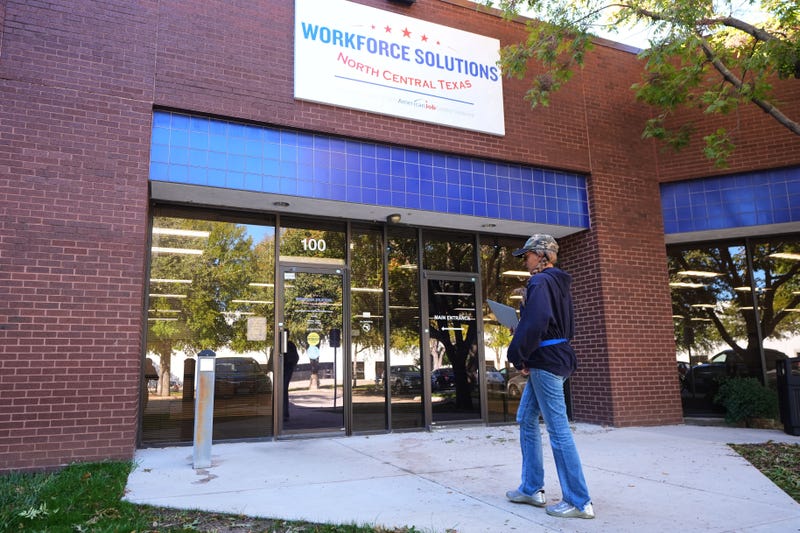
For more than two weeks now during the government shutdown, Imelda Avila-Thomas has been trying in vain to get approved for unemployment compensation to help cover essentials such as food and mortgage payments for her family while she's on unpaid furlough from her federal government job.
She kept asking questions and was ultimately sent a hyperlink to upload proof-of-income documents, which she did earlier this week. But Avila-Thomas, who works for the Department of Labor in San Antonio, said the system still deems her ineligible for benefits, saying it cannot verify her wages. She wonders whether someone who might help her has also been furloughed.
A mother of a 12-year-old daughter and local union leader, Avila-Thomas is among the thousands of furloughed federal workers trying to navigate the unemployment system — a sharp increase, but still a fraction of the 670,000-plus furloughed workforce, according to the Bipartisan Policy Center. The dollar amounts and length of benefits vary by state.
About 26,000 federal workers filed initial claims from Sept. 28 through Oct. 18, according to raw data published by the Department of Labor. Some 3,300 applied in the week that ended days before the Oct. 1 shutdown start.
Furloughed workers have some factors to consider. For instance, if they receive back pay as expected when the shutdown ends, they would need to repay the unemployment aid. For Avila-Thomas, refunding the money later is preferable to taking on debt.
Avila-Thomas has worked at the Labor Department for 16 years. Her husband is a disabled veteran who works for the Department of Veterans Affairs and is still working with pay, but they have had to cut back on tutoring for their daughter, who has dyslexia, and with one income now, they've gone to a food bank.
“This would cover that — the essential basics,” said Avila-Thomas, whose local American Federal of Government Employees covers Labor Department workers in several states. “And yes, in an ideal world, everybody would have six months worth of savings. And the reality is, most of our members are coming to that point where they could no longer pay those regular bills.”
She has applied for part-time work and said she isn’t looking for a handout.
Federal workers' jobless aid relies on states
Unemployment Compensation for Federal Employees relies heavily on state laws and processing.
The specifics vary. Massachusetts has a high-end weekly benefit of $1,105 per week for up to 30 weeks. In Mississippi, it’s no more than $235 weekly for up to 26 weeks. Roughly half the states pay less than $600 a week maximum, according to U.S. Department of Labor numbers.
Not everyone gets the maximum weekly rate. Some states offer fewer than 20 weeks. And the limits can grow in some states when unemployment rates are particularly high.
Around the nation’s capital, the maximum weekly payment is $444 in Washington, D.C., $430 in Maryland and $378 in Virginia.
In Texas, where Avila-Thomas lives, the weekly maximum is $605, for up to 26 weeks.
States normally issue payments within two to three weeks after someone’s claim is approved, the Labor Department says. And most states also have an initial “waiting week” for which benefits are not paid upfront. Beneficiaries typically receive money for that week only later, if they exhaust all the weeks they're allotted, the National Employment Law Project says.
States are responsible for verifying an applicant’s job and earnings with their federal employer. But the Department of Labor has warned that the shutdown may delay processing of this information by federal agencies.
Many workers have not received forms normally sent by their employing agencies that are used to verify employment and earnings, according to the National Employment Law Project.
Questions have come up about states' varying requirements that people prove they are job hunting while receiving unemployment checks. The Labor Department has said waivers of the requirement may apply for the furloughed federal workers under state laws, noting they face ethics limits on outside work. And some states have specified that work-search mandates won’t apply to these workers, waiving them for several weeks or longer.
But in Texas, Avila-Thomas said she has not received a clear answer. Many of her job matches could present a conflict of interest, she said. The Texas Workforce Commission did not immediately respond to a request to clarify the work requirement for those workers.
Those still working without pay are ineligible
About 730,000 federal employees have kept working without pay, according to the Bipartisan Policy Center, and they are generally not eligible for unemployment benefits. They will receive back pay after the government is reopened. Workers on reduced hours could be eligible for unemployment.
"Excepted” employees working without pay are typically necessary to respond to emergencies or ensure national security, such as air traffic controllers and airport security screeners.
The Trump administration has said pay will continue for some groups, including FBI special agents and military troops. Paychecks never stopped for some other workers whose departments, such as the Postal Service, rely on their own revenues or certain other funding sources.
There have been other wrinkles specific to how this administration has handled the shutdown, as well.
Earlier in October, the Trump administration threatened that back pay for furloughed federal workers would not be guaranteed, though he later backtracked on it. Trump has also sought to lay off more than 10,000 federal workers during the shutdown. A judge has blocked the layoffs while a lawsuit challenging them plays out.
Avila-Thomas said workers like her are ready for the shutdown to end.
“We’re ready to get back,” she said. “I think I’ve driven my family crazy with things and projects.” ___
Associated Press data journalist Larry Fenn contributed from New York.